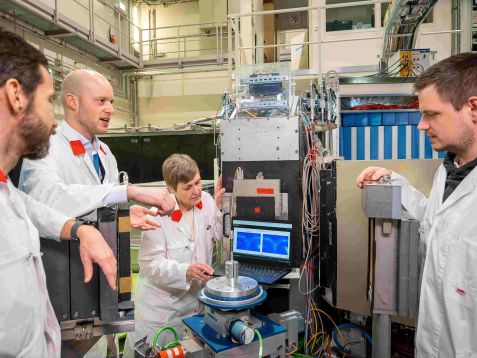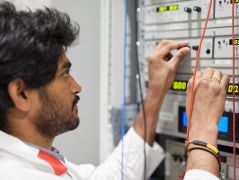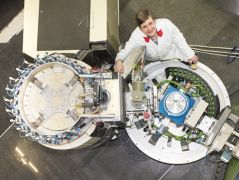MLZ is a cooperation between:
 > Technische Universität München
> Technische Universität München > Helmholtz-Zentrum Hereon
> Helmholtz-Zentrum Hereon
 > Forschungszentrum Jülich
> Forschungszentrum Jülich
MLZ is a member of:
 > LENS
> LENS > ERF-AISBL
> ERF-AISBL
MLZ on social media:

MLZ (eng)
Lichtenbergstr.1
85748 Garching
19.06.2023
Using measurement time more efficiently with machine learning
A scientific team from Forschungszentrum Jülich has developed a new approach at MLZ to improve the efficiency of neutron spectroscopy experiments and successfully tested it at the Swiss Paul Scherrer Institute (PSI). Neutron spectroscopy detects forces such as those between atoms arranged in an atomic lattice. The researchers optimized the data acquisition using an active learning artificial intelligence approach. This reduces the time per experiment and makes better use of the scarce resource of measurement time, especially in the first hours of an experiment.
Noise signals avoided as far as possible
In neutron spectroscopy, neutrons are directed onto material samples and then collected and analyzed by detectors. Some of the neutrons are scattered by the atoms of the sample, while some pass through without interacting. Only the scattered neutrons contain information, for example, how much energy the neutrons have gained or lost through the scattering process. The other neutrons produce what is known as “noise.” In order to waste as little time as possible measuring noise signals, the algorithm developed by Dr. Mario Teixeira Parente and his colleagues first takes measurements using a coarse grid in which the measurement points are evenly distributed. The algorithm then begins its actual work and uses this initial data to identify areas in which further measurements would be useful. With each additional measurement point, the algorithm continuously supplements its own database and then autonomously decides on the next measurement position. Because of the feedback loop, this approach is also referred to as “active learning.” Mario Teixeira Parente explains, “That is the strength of the algorithm: over time it figures out for itself where it is relevant to measure.”

Using measurement time more efficiently: Dr. Astrid Schneidewind and Dr. Mario Teixeira Parente (l.) examine the algorithm. © Astrid Eckert, TUM
Measurement time optimized
Neutrons provide unique insights into the structure and dynamics of matter. This requires large-scale research facilities, either research reactors such as FRM II or specific particle accelerators. For years, the number of available facilities in Europe has not covered the needs of research. Measurement time with neutrons is thus scarce and valuable. Methods for increasing efficiency can help to make better use of the available capacity and to reduce the gaps that arise. “The algorithm optimizes the use of the available measurement time, especially at the beginning of an experiment,” says mathematician Mario Teixeira Parente.
The core of the active learning algorithm is a mathematical distribution, the Gaussian curve. It describes a statistical distribution of data in the form of a bell curve. The researchers use this to specifically find areas with informative signals. Other mathematical “tricks” allow them to identify areas with both strong and weak signals and distinguish them from noise signals.

Teamwork: Dr. Mario Teixeira Parente (2nd from left) developed the self-learning approach together with Dr. Christian Franz (l.), Dr. Astrid Schneidewind (2nd from right) and Georg Brandl using examples on the MLZ three axes spectrometer PANDA. © Astrid Eckert, TUM
Test passed in real experiment
The researchers demonstrated the advantages of their approach in real neutron experiments at PSI and Institut Laue-Langevin (ILL) in France, on previously measured as well as on numerous synthetic data sets. Using practical examples and realistic scenarios, they showed that the available measurement time is used more efficiently compared to certain previous methods. Thus, there is nothing stopping an application on further three-axes spectrometers.
Original publications:
Mario Teixeira Parente, Georg Brandl, Christian Franz, Uwe Stuhr, Marina Ganeva, Astrid Schneidewind
Active learning-assisted neutron spectroscopy with log-Gaussian processes.
Nat Commun 14, 2246 (2023).
doi: 10.1038/s41467-023-37418-8
Mario Teixeira Parente
Behind the Paper: Towards AI-assisted neutron spectroscopy
Physics, 20. April 2023.
More information:
In addition to scientists from Forschungszentrum Jülich, researchers from the Paul Scherrer Institute were also involved in the development of the algorithm and the measurements. This work was supported through the project Artificial Intelligence for Neutron and X-ray scattering (AINX) funded by the Helmholtz AI cooperation unit of the German Helmholtz Association.
Contact:
Dr. Mario Teixeira Parente
Forschungszentrum Jülich
Data Driven Discovery
Branch office at Heinz Maier-Leibnitz Zentrum
Phone: +49 (0)89 158860-657
E-Mail: m.teixeira.parente@fz-juelich.de
Related News
-
05.07.2021
Making data available to all
-
02.05.2019
Exceptions become the rule
MLZ is a cooperation between:
 > Technische Universität München
> Technische Universität München > Helmholtz-Zentrum Hereon
> Helmholtz-Zentrum Hereon
 > Forschungszentrum Jülich
> Forschungszentrum Jülich
MLZ is a member of:
 > LENS
> LENS > ERF-AISBL
> ERF-AISBL
MLZ on social media:





